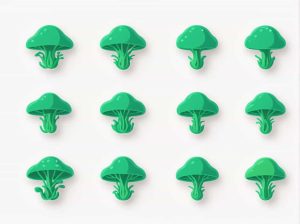Seaweed and Spirogyra both belonging to the algae family have a unique mucilaginous cover that serves several important functions. This gelatinous layer mainly composed of polysaccharides helps these organisms survive and thrive in aquatic environments.
The mucilaginous covering provides protection moisture retention buoyancy and defense against predators. In this topic we will explore its composition importance and how it contributes to the survival of these aquatic plants.
What Is the Mucilaginous Cover?
Definition and Composition
The mucilaginous cover is a slimy gelatinous substance found on the outer surface of many algae including seaweed and Spirogyra. It is primarily composed of:
- Polysaccharides (complex carbohydrates)
- Glycoproteins (protein-sugar molecules)
- Water-binding compounds
This layer helps algae adapt to different environmental conditions preventing dehydration and mechanical damage.
Where Is It Found?
- Seaweed: Marine algae found in oceans and coastal regions.
- Spirogyra: A type of freshwater filamentous green algae.
Despite differences in habitat both rely on their mucilaginous coating for survival.
Functions of the Mucilaginous Cover
1. Protection Against Desiccation (Drying Out)
In aquatic environments algae are often exposed to changing water levels and harsh conditions. The mucilaginous layer helps retain moisture preventing the algae from drying out when exposed to air during low tides or droughts.
For Spirogyra which thrives in freshwater ponds the slimy layer keeps it from drying up when water levels fluctuate.
2. Defense Against Predators
The slimy texture makes seaweed and Spirogyra less appealing to herbivorous fish snails and other grazers. Many predators find it difficult to grasp or consume algae with a thick mucilaginous coating reducing the risk of being eaten.
Some species even produce toxic or unpalatable mucilage further deterring herbivores.
3. Protection from Harmful UV Radiation
Algae especially those living in shallow waters are exposed to intense ultraviolet (UV) radiation from the sun. The mucilaginous layer acts as a natural sunscreen absorbing harmful rays and reducing DNA damage.
4. Aiding in Buoyancy
For Spirogyra and certain seaweeds the mucilage helps in floating and maintaining position in water. This is crucial for photosynthesis as it ensures that algae remain exposed to sunlight rather than sinking to darker depths where light is scarce.
5. Preventing Mechanical Damage
Strong ocean currents waves and turbulence can physically damage delicate algae. The slimy covering acts as a cushion reducing the impact of water movement and preventing breakage.
6. Facilitating Reproduction
The mucilaginous layer plays a role in spore dispersal and zygote protection in some algae. For instance in Spirogyra mucilage helps in the formation of protective layers around zygospores ensuring their survival until favorable conditions return.
7. Preventing Microbial Infections
Water is full of bacteria fungi and parasites that can harm algae. The mucilaginous layer acts as a barrier preventing harmful microorganisms from attaching to the algae’s surface. Some species even produce antimicrobial compounds within their mucilage to further resist infections.
8. Reducing Competition with Other Organisms
Mucilage can make it harder for other aquatic organisms such as barnacles and epiphytes to settle on the surface of seaweed and Spirogyra. This ensures that algae receive adequate sunlight and nutrients without being overgrown by competitors.
Importance of the Mucilaginous Cover in Ecosystems
Maintaining Water Quality
Mucilage traps sediments and pollutants preventing them from spreading in the water. This improves water clarity and quality benefiting nearby aquatic life.
Supporting Marine and Freshwater Food Chains
Although it deters predators mucilage is still a food source for certain microorganisms contributing to the nutrient cycle in aquatic ecosystems.
Aiding in Carbon Sequestration
By trapping carbon within its polysaccharide structure mucilage helps reduce CO₂ levels in aquatic environments playing a role in climate regulation.
Applications in Human Use
1. Pharmaceuticals and Medicine
The polysaccharides in seaweed mucilage have anti-inflammatory antiviral and wound-healing properties making them valuable in medicine. They are used in:
- Skin treatments (moisturizers burn creams)
- Antiviral drugs
- Wound dressings
2. Food Industry
Many seaweed-derived polysaccharides such as agar carrageenan and alginate are used as:
- Thickeners in soups and sauces
- Gelling agents in desserts and dairy products
- Stabilizers in ice cream and yogurt
3. Biotechnology and Industry
Mucilaginous extracts from seaweed are used in:
- Biodegradable packaging
- Water purification systems
- Agricultural fertilizers
The mucilaginous cover in seaweed and Spirogyra serves multiple vital functions from protecting against dehydration and predators to aiding in buoyancy and reproduction. It not only benefits these organisms but also plays a crucial role in aquatic ecosystems and human applications.
Understanding the significance of this slimy layer helps scientists develop new ways to utilize algae for environmental and commercial purposes making it an essential topic in marine biology and biotechnology.



